
|   |

|   |
 e-mail: sunilkothari1933@gmail.com Natya Bharatiyam Photos courtesy: International Dance Research and Training Centre May 13, 2017 International Dance Research and Training Centre, Hyderabad, presented a three day classical dance extravaganza Natya Bharatiyam consisting of solo Kuchipudi, group Bharatanatyam, group Kuchipudi, Kuchipudi dance dramas, group Odissi, group Kathak and also on the final day devotional songs at the Shilpa Kala Vedika auditorium at Madhapur, High Tech City, from 24th till 26th April in the evenings from 5pm. And every day it concluded around 9.30pm on account of a large number of participants. After the concluding day, I learnt from the organizers that in all 192 dancers and musicians participated. Madhavi Puranam, the editor of Nartanam quarterly, had a year ago arranged documentation of Kuchipudi dance dramas and Yakshaganas at Kuchpudi village in collaboration with Sangeet Natak Akademi. It was a huge affair. In December last year, Andhra Silicon Valley's Anand Kuchibhotla had arranged Kuchipudi Mahabrinda Festival at Vijayawada in keeping with his earlier similar Mahabrinda Festivals of Kuchipudi winning Guinness Book Records. It is on account of Anand Kuchibhotla's Andhra Silicon Valley group of people, whose organizing capacity is amazing, that such events are held on such grand scale. The chief organizer of the three day Natya Bharatiyam is a young, 28 year old, traditional Kuchipudi dancer Dr. Tadepalli Satyanarayana Sarma from Kuchipudi village. His paternal grandfather Tadepalli Chandraiah was known for his Kuchipudi Pagativeshams and Kalapams. Satyanarayana's great grandfather Tadepalli Periya Sastry was the guru of Vempati Chinna Satyam. Periya Sastry and his lineage were known to support accompanists, mridangam players, nattuvanars, and literary figures for Sampradaya Bhagavata Melam. Satyanarayana is possessed with the idea of reviving the fast disappearing Yakshaganas and Kuchipudi Nritya Rupakas with the establishment of International Dance Research and Training Centre (IDRTC). In Kuchipudi village, as a young disciple of great masters, he continued to dream about one day performing at a big auditorium. And he did realize his dream. However, his sympathies extend to young children and he wishes to provide an opportunity to them to perform at, no less than a prestigious auditorium like Shilpa Kala Vedika which has state of art facilities, vast stage, and facilities of projection of scenes and a capacity of more than 2000 audience. There is nothing wrong with this ambitious plan and dreams. It requires amazing organizational abilities, which it seems Tadepalli Satyanarayana is capable of. But curating such a festival needs a critical approach. Tiny tots when they perform, invariably steal hearts of audience, let alone their parents. But to present groups of varying ages of dancers creates an uneven level of standard. Also along with that, to have Kuchipudi dance dramas following the example of Vempati Chinna Satyam and mega productions, pose another set of problems. With some reservations, it would be nice to assess the present dance scene in Hyderabad. And in general of the possibilities of how one can contribute to its future development. Opening the festival, local Bharatanatyam dancer Chitra Narayanan who runs Bharatha Naatyalaya, presented her students. Their prayer in praise of Ganapati, Shuddha Vinayaka namo namo followed the usual attributes of Ganapati and in final position his iconic image with four dancers was shown like a tableau. A dancer standing behind the main dancer spreading her hands with two hands of main dancer, showing chaturbhuja - four arms - and Ganapati's vehicle mushaka - mouse - was shown and other dancers stood folding hands in obeisance. 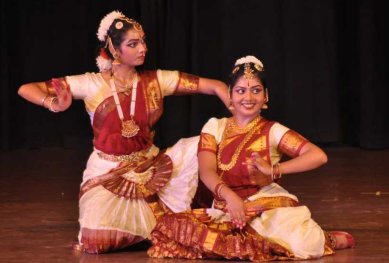 Chitra Narayanan's students 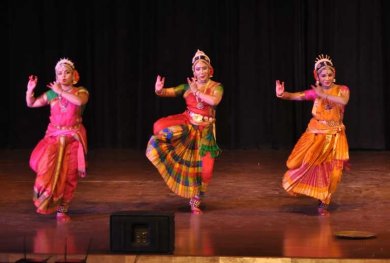 Vasanth Kiran's students In Kuchipudi, Dr. Vasanth Kiran, Professor and Head of Alliance University, Bangalore, presented his three sprightly young dancers. They stood out for Vasanth Kiran's choreography, neatness, sparkle, perfect alignment in movements and eye catching aharya. It was a sophisticated presentation which won rounds of applause for their quicksilver movements. In the number Salam Kuchipudi, Vasanth Kiran incorporated the major aspects of history of Kuchipudi with its gradual development and excerpts from Bhama Kalapam and in the end dancers executed the salutation as Salam which referred to Abdul Hasan Tanishah who gifted Kuchipudi village to Brahmin performers. Dr. Balamurali Krishna's tillana in Kathanakuthuhalam raga was performed with alacrity and coordination. The accomplished dancers were from Kerala with excellent training; even when the old guards did not approve of their executing the adagulus, as in old tradition, the dancers impressed the audience. This is bound to happen as Vasanth Kiran needs to keep pace with the contemporary times embellishing the form. Chavli Bala Tripurasundari, daughter of Vempati Chinna Satyam, presented disciples from her institution Abhinaya Vani Nritya Niketan . The stuti in praise of Ganapati had all the charm of Vempati bani. Set to Ragamalika it depicted the beauty of the god, devotees reciting aharnisham gajanana upasmahe, always worshipping Lord Ganapati day and night. The four dancers showed commendable grasp of the technique. In Vrindavana nilaye in Ritigowla raga and adi tala, three dancers performed in unison, entering with a pose of holding veils, looking from it and as the song progressed, the word 'rasollasa' indicating shringara was suggestively depicted. Tillana in Hamsanandi was faithful in its execution to Vempati bani and had gradual progression. It was good to see Vempati's bani maintained without distorting it. Dr. Himabindu Kanoj presented her disciples under the aegis of Muvva Nritya Raga Namam. She presented many sequences of Ramayana story familiar to audience. Ending with Rama Rama jaya Raja Ram, it was a thematic presentation of bhakti. The Tillana in Kathanakuthuhalam seemed a favourite with dancers. Nine dancers performed it in a joyous mood. The 45 minute long Kuchipudidrumam dance drama by Surendranath and his troupe from Vijayawada traced the history of Kuchpudi in traditional manner with Ambaparaku prayer and sutradhara narrating story, followed by a long duet of Shiva and Parvati, with backdrop of temple and the Himalayas. After the story of churning of ocean, Mohini distributing nectar to asuras, asuras getting mad, it traced the recent history of revival of Kuchipudi with projection of photos of various senior gurus of different families like Vemapti Chinna Satyam and several other traditional gurus. The libretto was written by well known poet in Telugu, the elder brother of D.V.S. Sastri. Sastri's singing was excellent and Surendranath has well equipped dancers proficient in technique. But the entire production needs revision and editing. It was not coherent in concept. Showing photos of contemporary gurus, some no more, was interesting. However an excerpt showing choreography of Vedantam Raghavaiah to introduce dance in films was not properly featured. A lot of work was undertaken in choreographing and mounting this production, but it lacked in artistic presentation. 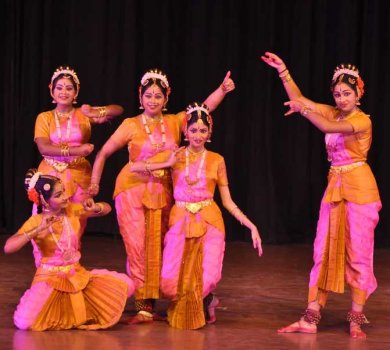 Himabindu Kanoj's group 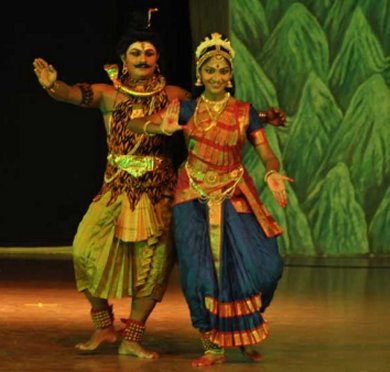 Surendranath's group 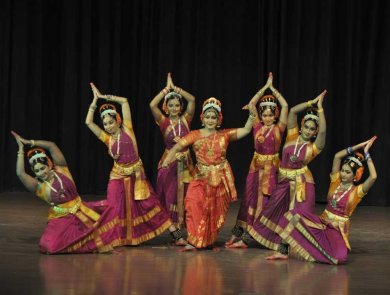 Nirmala Visweswaran's group 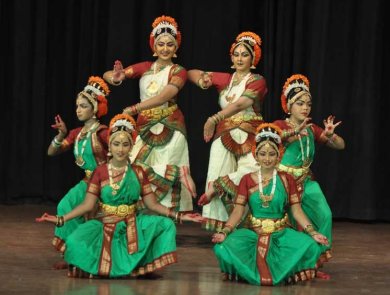 Rama Devi's group On 25th April, Nirmala Nritya Niketan presented students in Kuchipudi under guidance of Nirmala Visweswaran. It was an average presentation and since group dances were to be performed to accommodate many students it looked almost a routine affair. Dr. Rama Devi presented her students of Sri Sai Nataraj Academy of Kuchipudi Dance. Their training was praiseworthy. The standard was better, as Dr. Rama Devi pays attention to basic movements and has an eye for visuals and choreography. Students of Rinda Saranya Kuchipudi Dance Academy presented four dancers trained by Dr. Yashoda Thakore. Yashoda had to attend another event, therefore she was not present. Unfortunately the standard appeared very poor. When the four dancers performed Tarangam, their description of Krishna wearing ankle bells and other ornaments was not correctly depicted. While dancing on brass plate, the dancers displayed nupur on arms, near wrists. I was quite surprised that Yashoda Thakore's students would commit such mistakes. Their alignment in movements was not perfect. They lacked in stance and frankly one was disappointed to see such presentation. Yashoda is a serious dancer and has earned reputation for her abhinaya and reviving old dance tradition, abhinaya of Kalavantulu. She has great responsibilities and I am sure in future she will be careful. The saving grace for the evening was Dr. Maddali Usha Gayatri's choreography of dance drama Goda Kalyanam in Kuchipudi. The story is well known as the same story is performed as Andal Charitram in Bharatanatyam. Usha Gayatri is a versatile dancer, guru and choreographer, trained by Jagannath Sarma, son of Vedantam Lakshminarayana Sastri. The story unfolded dramatically. The dancer who played Goda is a software engineer and one who played Rangaswami is a doctor. They both were performing after an interval of twelve years. But they acquitted themselves well in their respective roles. The final scene of marriage reminded me of many similar scenes from Vempati Chinna Satyam's dance dramas. It looked gorgeous and the various divine celebrities, devas attending marriage looked grand. Only the showering of flowers from above was missing. But surely Usha Gayatri's guru must be showering blessings on her for such commendable dance drama with good music. On 26th April, the organizers had to combine the dance performances by few groups which were to perform on 27th April, as the auditorium had to be given for some government event. So the program was too heavy with so many dancers to be accommodated. From Bangalore, Madhulita Mohapatra's Nrityantar Dance Ensemble presented delectable Odissi. The five dancers well trained by Madhulita in her guru Aruna Mohanty's Odissi style reflecting the bani of Guru Gangadhar Pradhan, displayed coordination in Pallavi in Janasammohini raga, choreographed by Madhulita. It incorporated several sculpturesque poses and eye catching groupings. The various stances of Odissi including alasa, darpani were seen to great advantage. The abhinaya pada Baju chhi bajaare, depicting clandestine love between Radha and Krishna is one of my favourite songs. It shows the delicate feelings of love between Radha and Krishna. The music is melodious. Sakhi tells Radha that, “all your antics are known to people. We know why you go to the terrace pretending to dry your wet hair, because Krishna is going to pass through the street and you and he with your eyes convey your love- this is no more a secret. Do we not know why you go to Jamuna to fetch water? O Radha, believe me, Krishna's advances are known.” Madhulita and her disciple performed with complete involvement. 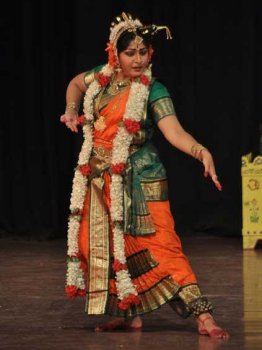 Maddali Usha Gayatri 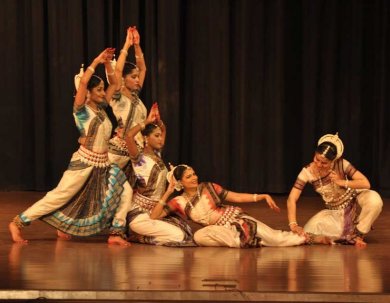 Nrityantar Dance Ensemble 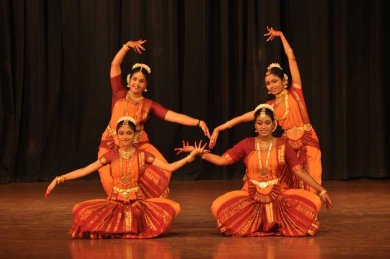 Smitha Madhav's group 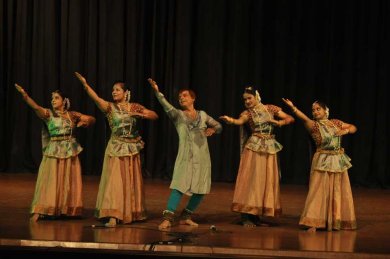 Sanjay Joshi's group Smitha Madhav's Varna Arts Academy presented sabdam in Bharatanatyam. The tiny tots did well capturing the attention of the audience as all tiny tots do. We were expecting Smitha to perform as she has good training from Sai Rajeswari. Her attempt to present Mallari in another raga was welcome, but it did not achieve any novelty. The standard in such cases looks not up to the mark. Smitha would do well to avoid imbalanced presentation. Sanjay Joshi runs Parampara Centre for Performing Arts. He has studied Kathak under old masters in Hyderabad and later on under Kumudini Lakhia at Nrityagram. His presentation of Kathak had old world charm. The traditional Shiva kavit, stuti, and prayer were well executed. The parans, tode, ladi tatkar, tarana were all within tradition. His four female dancers performed with enthusiasm. But they need to improve their stances. Sanjay needs to expose them to recent trends in Kathak. In order to keep pace with changing times, Sanjay needs to make attempts to expand his repertoire. His Kathak looked dated and lacked sparkle. Pallavi Academy of Fine Arts's presentation of dance drama Aarishadvargalu, and dance by students from Vijayawada based Sri Sappa Siva Kumar's Sri Vagdevi Kuchipudi Nrityalaya did not leave any impression and in such an overcrowded program, such productions sink without leaving a trace, defeating the purpose of the festival. Uttara Centre for Performing Arts presented Geetha Ganesan's students in Bharatanatyam. They were better in terms of technique and group choreography. The highlight of the evening was a solo recital by Katyayani Ganti, who has earned her Ph D from Hyderabad University and is a versatile mature Kuchipudi exponent. In Oothukadu Subbaiyar's Navavarna kirtana she revealed her potential as a brilliant performer. She has a commanding stage presence, expressive eyes and registers bhavas with communicative skill. The composition is subtle, with nine layers. Her portrayal of Raja Rajarajeswari was outstanding. Katyayini brought out vividly all the epithets like Chaturbhuja, Raktavarna, Chandrarekhavibhushita, Chapapushpeshupashankusha, Chidagnikundasambhuta, Shankari Rajeswari. As a matter of fact this particular work can become her brand, so powerful is it in its presentation. Kudos to D.V.S. Sastri for assisting her in choreography and composing hauntingly melodious, at times raudra, at times gentle, music to suit the enactment of the goddess. Here is a dancer to watch. Doubtless she is bound to go places. 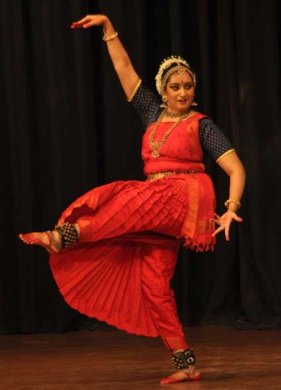 Katyayani Ganti 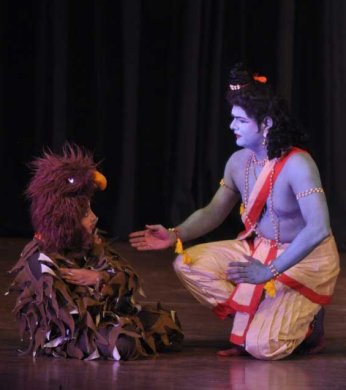 Jaya Vijayulu The finale with Ajay Chakravarthy's group from Hyderabad, in Kuchipudi dance drama dwelling upon the story of Jaya Vijayulu, was a saving grace of the festival. Though Ajay used state of art projection of slides to show the royal court, the temples, the doors of Vaikuntha opening one by one and had shining golden crowns, necklaces, royal costumes, and the vachikabhinaya had mesmerizing quality of engaging audience in the unfolding of the drama, with all the promise he shows, a lot of editing and pruning is required to raise it to an aesthetic level. As Hiranaksha, Hiranyakashipu, Shishupala and in other roles Ajay gave glimpses of late Rattaiya Sharma. He seems to have inherited his powerful personality, except that sometimes the acting borders on hamming. The overall impression the production gave was of possibility of reviving Yakshagana, Kuchipudi dance drama genre with excellent Telugu libretto and D.V.S. Sastri's music. Even when the back projection in last sequence after Krishna is given honours in Rajasuya sacrifice and Shishupala insults Krishna, and the Sudarshana chakra chases Shishupala, shown through projection, one gets involved in that dramatic enactment. Audiences would love it. His dancers also show potential as actors in such productions. As a matter of fact, since Kuchipudi has come to stay in its solo avatar along with dance dramas, these two contrasting presentations made it clear that there is some hope of reviving the dance drama productions in their full glory. It was getting pretty late, therefore I did not attend the Gazals and Bhajans program of Devi Ramana Murthy and group. I was told that the group enjoys very high reputation. Tadepalli Satyanarayana is full of enthusiasm, passionate about reviving dance drama tradition of Kuchipudi and is also capable of managing to raise funds through his own vocation as a religious priest and able to support his own group in Kuchipudi village. He also has the ability to organize festivals on a large scale. After watching the sumptuous fare for three evenings, we wondered on the purpose of mounting such a festival. So, Anuradha Jonnalagadda, some senior dancers and students completing MA and pursuing Ph.D, Satyanarayana and I sat together for a post mortem. He explained that he plans to hold a ten day festival so that each aspect of Kuchipudi dance drama can be analyzed, demonstrated, questions asked, opinions sought, other choreographic works of different dance forms (like Bharatanatyam, Kathak, Odissi) be presented in the evening along with one Kuchipudi dance drama every night, so that Kuchipudi artists can see other works, for instance, Kalakshetra dance drama, Ratikant Mohapatra's choreography in Odissi, choreographic work in Kathak and observing other performances, take elements which would better the Kuchipudi dance drama form. Ten days is a long period and maybe some of us cannot afford to spare so much time. But in principle, the idea is good. The Dance Research and Training Centre needs to instill among young generation the need for study of Sastras. Since funds will not be a problem, the most important thing would be to audition the groups invited from Kuchipudi to participate. Also other choreographers from outstation could stay back to assist in evaluating Kuchipudi dance dramas. Then the interaction would be of help. He could have separate festival for young children, young dancers. For major work he must not mix up standards and must not be sentimental. He seemed to appreciate our feedback and hopefully will be more discriminating in selecting the groups.  Dr. Sunil Kothari is a dance historian, scholar, author and critic. He is honored with Padma Shri, Sangeet Natak Akademi award and Senior Critic Award from Dance Critics Association, NYC. Post your comments Please provide your name and email id when you use the Anonymous profile in the blog to post a comment. All appropriate comments posted with name & email id in the blog will also be featured in the site. |